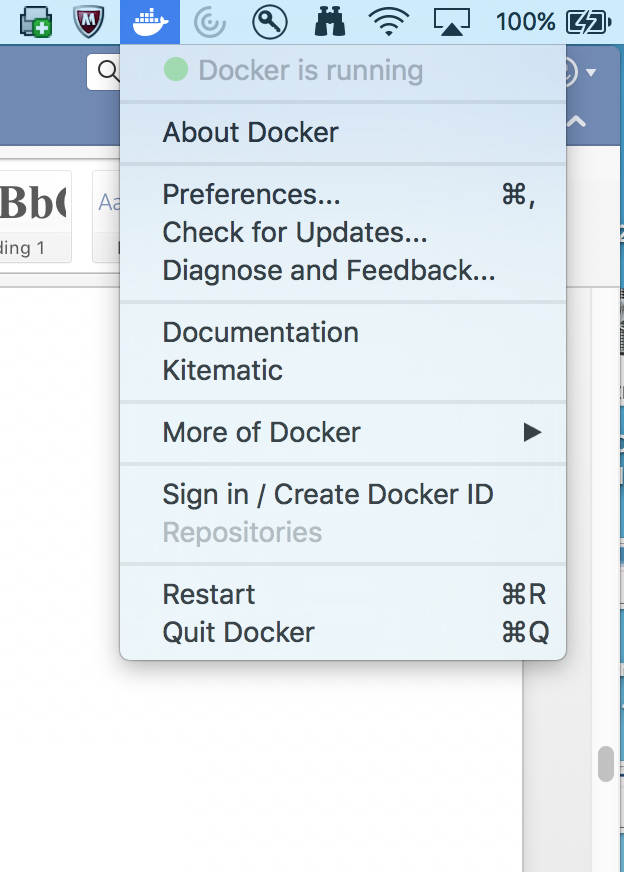
- Kitematic mongo for mac#
- Kitematic mongo install#
- Kitematic mongo software#
- Kitematic mongo windows#
Search for MSSQL and you will find the official mssql-server-linux image from Microsoft. You are running your first Docker container.Ĭertainly we need to configure the container to use it for our purposes. Just search for the one you want, click create and you are done. Just open Kitematic and you get an overview of the images that are available. Now I show you how easy it is to get a Docker container up and running.
Kitematic mongo windows#
Note: If you are using Docker on Windows you must decide if you want to use Windows or Linux containers.
Kitematic mongo install#
To install just klick on Kitematic in the Docker menu and follow the instructions. Here I will mostly use the Kitematic GUI and only switch to CMD for special operations that are not supported in Kitematic.

Therefore I recommend to install Kitematic which is a GUI that supports basic operations of Docker like installing images and configure the settings of your containers. You can run Docker completely in the Command Line but some things just are easier with a GUI.
Kitematic mongo for mac#
Apache Solr, MSSQL or MongoDB just to name some that can be important for Sitecore Devs.įirst of all download Docker for Mac or Windows and run the installer.
Kitematic mongo software#
A lot of big software companies create Docker images of their products that you can use out of the box eg. Just for those who have never heard of Docker (which may be few): Docker is a container virtualization that allows you to package up an application with all the parts and dependencies it needs. I was searching for ways to save as much ressources on my VM as possible and to make my development environment as flexible as possible and in time I became aware of Docker. This has to do with my history as Mac guy and my difficulties to adapt to the Windows system's behaviour. As strange as this may sound but I am developing Sitecore on a Mac with Windows running in a VM. When I finally noticed that in step 2 I had to properly select Ubuntu 16.04 (for me), the install was successful and after this mongod ran without any issues.Today I like to show you how Docker can be a really good companion for a Sitecore developer. By default it shows Ubuntu 14.04, which created the problems mentioned by OP (Failed to start rvice: Unit rvice not found) NOTE: in step 2 of the tutorial (create a list file for Mongodb), it is important to click on the tab specific to the particular version of Ubuntu on your machine.

I too faced the exact problem mentioned by OP, even though I installed Mongodb using the official install tutorial ( ), The issue is that your system couldn't find rvice when you run sudo service mongod status. Now you can see mongod working but still the same issue is bothering you. To install a specific release, you must specify each component package individually along with the version number, as in the following example: sudo apt-get install -y mongodb-org=3.6.0 mongodb-org-server=3.6.0 mongodb-org-shell=3.6.0 mongodb-org-mongos=3.6.0 mongodb-org-tools=3.6.0 Now reinstall mongodb using following commands: sudo apt-key adv -keyserver hkp://:80 -recv 2930ADAE8CAF5059EE73BB4B58712A2291FA4AD5Įcho "deb xenial/mongodb-org/3.6 multiverse" | sudo tee /etc/apt//mongodb-org-3.6.list Uninstall your mongo completely from your system: sudo service mongod stop Then all I had to do was copy my correct config to /etc/nf and run sudo service mongod restart Running this fixed it and restored the service: sudo systemctl enable mongod The problem was that my system couldn't find rvice when I ran sudo service mongod status. I reinstalled mongod-org, since my data will still stay safe.


 0 kommentar(er)
0 kommentar(er)
